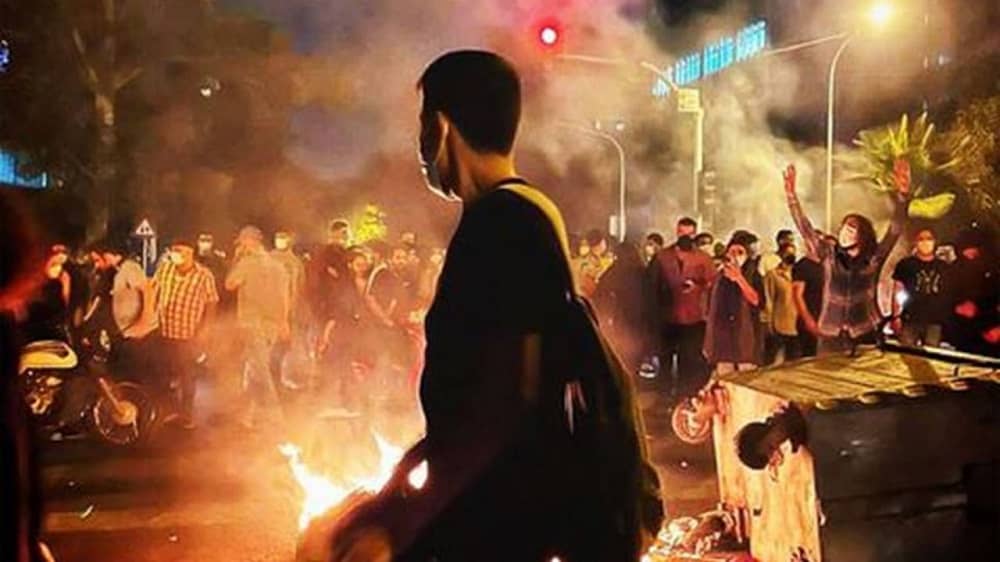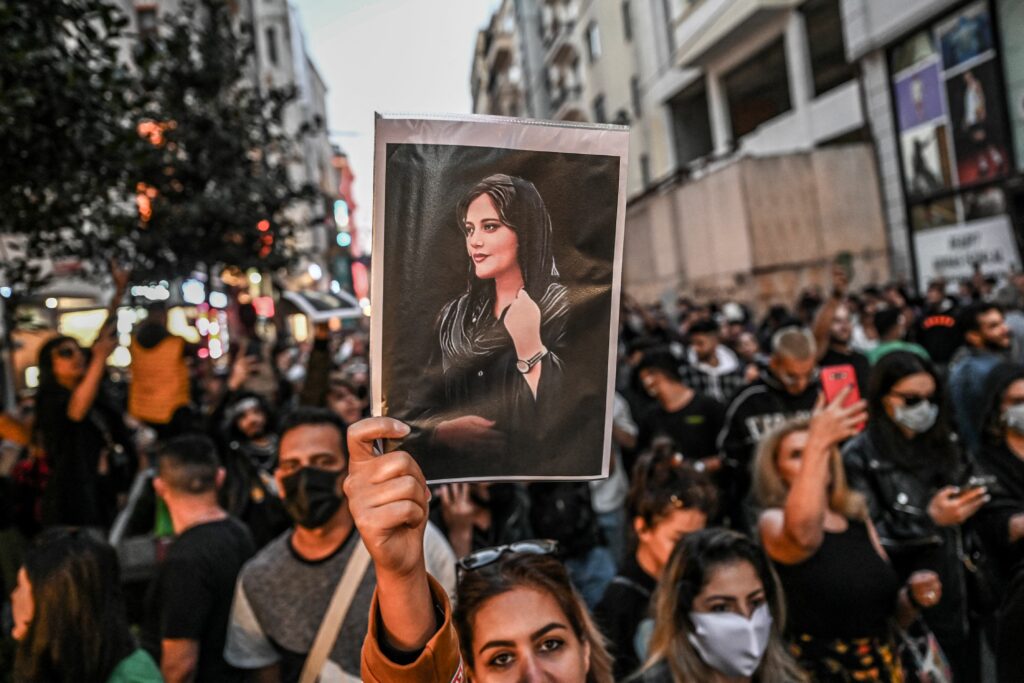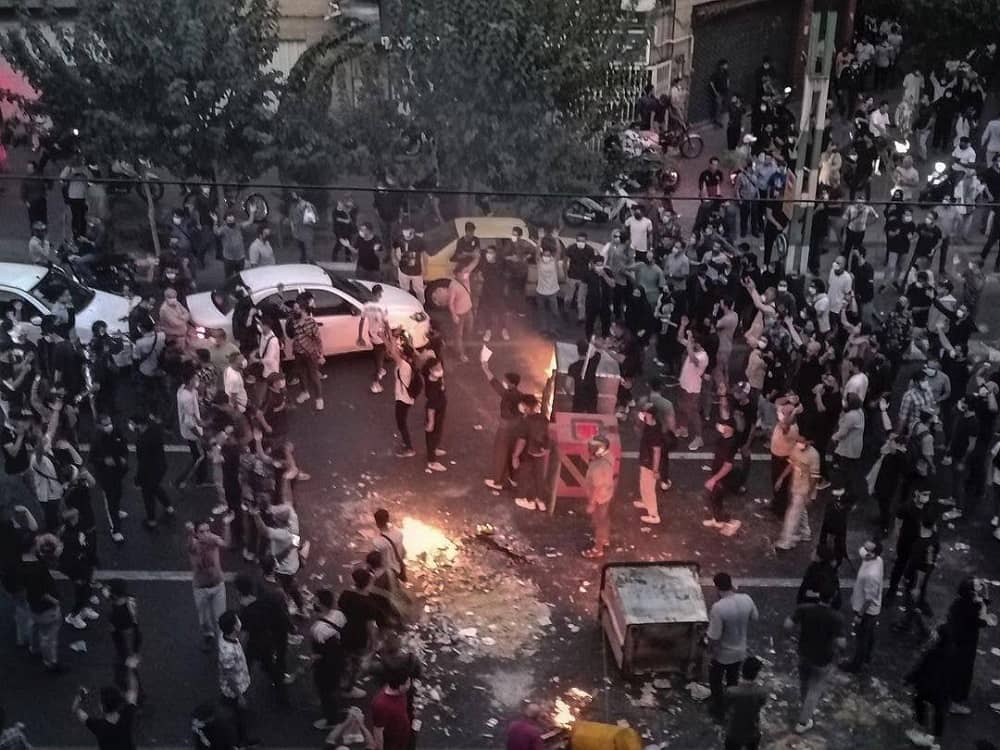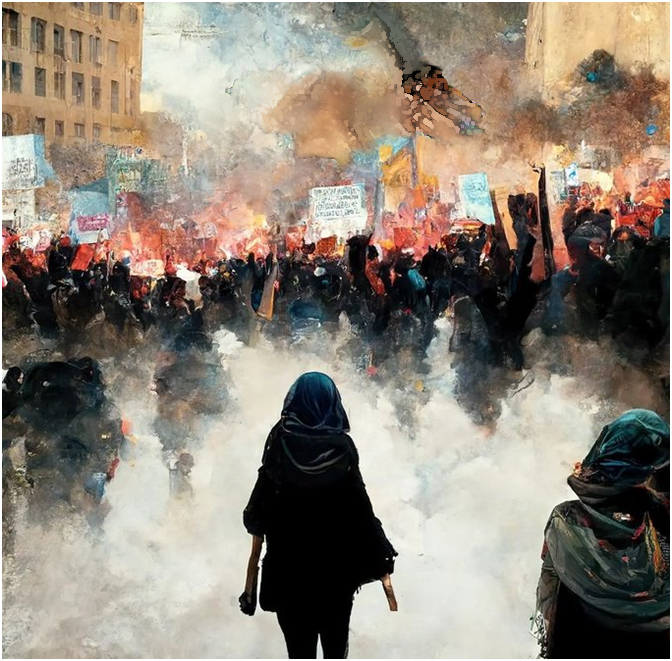It has been four month since the latest uprising in Iran began. The movement has waned for now, although there are still demonstrations and riots in the provinces of (Iranian) Kurdistan and Baluchestan. There still are some strikes going on as well, by petrochemical workers in Bandar Mahshahr in the south and others, but they are not directly linked to the earlier protests. Most are against the increasing practice of delaying the payment of wages for several months, which is an effective way to increase exploitation. It leaves the workers in dire straits and when they’re so lucky to get their back wages, inflation had bitten off a great chunk of it.
In the reports of pro-revolutionaries in Iran [dndf.org] , two reasons are given for the decline of the uprising: the ferocious repression and the extreme cold. The repression was indeed ruthless but in the beginning of the movement this seemed to make the masses only angrier, more determinant. It was toned down for a while, the government made some conciliatory promises, but when the movement had crested and lost strength, it became more ferocious and more effective.
That the cold played a role seems likely. Iran had not experienced such freezing weather in more than a decade. It emptied the streets as people huddled inside. Gone were the masses who by their presence and sympathy gave protection to smaller groups that were the spontaneous vanguard of the revolt.
And yet. The October-revolution triumphed in freezing weather. Not every season may be equally suitable for an uprising but they have occurred in all seasons. It is true that the cold chased the proletarians in Iran inside but there they encountered exploitation in another form. Because of technical malfunctions, gas delivery to homes was cut off repeatedly in many regions. This was not so much a willful policy than a consequence of under-investment in its aging infrastructure, aggravated by Western sanctions. Of course, its weapon industry suffers no such problems. The irony is that Iran has, after Russia, the largest gas reserves on earth. The decay of the civilian infrastructure testifies to the growing difficulties the regime encounters in fulfilling its function as managers of Iranian capital. Not only houses were cut off, but also entire industries. Schools, administrations and factories had to close. It paralyzed the country more than the strikes and the riots did.
But for the workers, the deprivation of warmth to their homes was an attack on them as a class. It required a class response, not only despite the cold, but also because of it. It was a general strike of the working class which brought down the regime of the Shah in 1979. What that yielded for the workers was new masters who were no less ruthless and exploiting than the old ones. It is hard to assess how strong the grip of those new masters remains today. As the crisis deepens and the current ruling class more and more fails to assure the reproduction of the working class, the reasons to revolt will multiply. Eventually, the regime will go the way of the Shah. Hopefully the workers then will not choose new leaders to rule and exploit them but find ways to live and meet each other’s needs without rulers and exploiters. But that depends not only on what happens in Iran.
The article below first appeared in La Oveja Negra. It gives a fine overview of the current movement up to December 2022, explains the particularities of the Islamic management of capital, the role of religion and of the oppression of women. It analyzes events since the fall of the Shah from the point of view of the working class.
Internationalist Perspective

RIOTS IN IRAN
When we get news from distant countries, despite cultural and geographic differences we can quickly see common structural issues. This why we can identify with those who rebel against the established order in different parts of our planet. We hear of the uprisings in Iran through news, pamphlets and texts. Understanding the international character of the class struggle is the point of departure for any agitation for world revolution against Capital.
While on holiday with her family in Tehran, Mahsa Amini, a 22-year old woman, was arrested on September 13 by the Gasht-e Ershad ‘Guide Patrol’, also known as the Morality Police. She was accused of wearing the hijab ‘inappropriately’ and taken to a detention centre for re-education. Two hours later she was taken, comatose, to a hospital where she died on September 16. The police said she suffered a sudden heart attack. Her relatives witnessed her beating in detention and watched as she lost consciousness.

On Saturday the 17th, during her funeral in Saqez, protests began with a group of Kurdish women removing their veils, some burned them. The next day, the demonstrations spread to cities across the country. Different sectors of workers went on strike, a large number of shops closed in support of the protests and since then various expressions of struggle have followed one another continuously.
“Death to the dictator!”, referring to Ali Khamenei, the ‘Supreme Leader of Iran’, has been the most often shouted slogan along with “Jin, jiyan, azad! (“Woman, life, freedom!”). This last slogan in Kurdish is an act of solidarity on the part of the rest of Iran towards the Kurdish region bordering Iraq and Turkey. Jina (“the one who gives life”) is the Kurdish name that Mahsa’s parents were not allowed to give her in Saqez twenty-two years ago.
As the reproducers of the population, women are life and life emanates from them; they are at the centre of societies and are the starting point of all the processes of production. The Islamic Republic has understood the meaning and weight of this role so well that it seeks to reduce women to property, of which the hijab is the symbol. The open question, in the context of international struggle of the women’s movement, is to be able to advance the question of the sexual division without having to follow the liberal parameters of the West. It is not simply a question of equality, but one of subverting division itself.
The women’s situation was the trigger for a revolt that has developed and strengthened from the unbearable living conditions of the proletariat in Iran and its countless struggles. And it is precisely from these struggles that we understand the implication (and not the intersection) between gender assignments and exploitation, between production and reproduction.
In Iran, given the theological regime established by the so-called ‘Islamic Revolution’ of 1979, control and repression are imposed religiously. Since the establishment of the present regime, there have been various forms of this ‘morality police’. The repressive forces loyal to the regime are delegitimized and demoralized, and more and more women and girls are proudly not wearing the hijab while passers-by give them complicit and encouraging smiles.
For 43 years, a bourgeois regime with Islamic characteristics has ruled Iran. It is an Islamic Republic that, after the fall of Shah Reza Pahlavi, combines an Islamic theocracy with representative democracy, through a complex network of elected and non-elected institutions. Power is concentrated in the Supreme Leader, a position held by Khomeini from 1979 to 1989, and by Khamenei from 1989 to the present day.
Iran is facing relative international isolation and growing internal difficulties due to the characteristics of its economic development.
A particular management of capital
Land rent (mainly oil and gas), unproductive industry, high inflation, devaluation and parallel exchange rates, falling real wages, high levels of unemployment, informal work and the so-called surplus population, subsidies and state aid (both to proletarians and companies), which implies a great development of corruption. Certain features of the Iranian economy sound familiar to us here in Argentina.
But not every rentier economy is limited in the same way. Populism, the interference of the State and its patronage networks, is reproduced in Iran in an extreme way, in which religion plays a fundamental role.
All States have a certain economic weight and productive activities; there are companies in which states are constituted as majority shareholders or even state-owned industries, but the Islamic Republic itself has become a productive relationship because of the way it has evolved. It is the starting point and the end point, determines the ownership of Capital and chooses the path of its growth. Being based on oil rents, its existence becomes more difficult and unproductive for large sectors of the economy, since it hinders the ‘normal’ development of economic activity based on competition.
It is in this framework that we must understand the different fractions of the Iranian bourgeoisie. Let us start with those with the greatest history, such as the sector of the big merchants called bazaris, bourgeois dedicated to trade who, faced with defective local production oriented to the domestic market, have enriched themselves on the side by managing imports with generous bonuses from the State. Oil revenue has largely been used to import consumer goods and equipment, with bazaris as the middlemen.
On the other hand, from the properties expropriated after the 1979 revolution and their subsequent support through rent, powerful religious foundations called bonyads have been formed which, aside from maintaining a patronage system through assistance to the poor, have become consortia of tax-exempt companies that depend directly on the “Supreme Leader”. It is estimated that these foundations control around 20% of GDP, trying to guarantee support for the regime.
Since 1990, there has been a slow privatization of state enterprises and a relative opening of foreign trade, resulting in the creation of a bourgeoisie that lives and enriches itself under the tutelage of the state. Most of the time, the beneficiaries of these “property transfers” are the directors of these formerly state-owned enterprises.
The Islamic Republic has from its beginning, in addition to the regular Iranian army, built a parallel army of greater status and loyalty to the regime called the Revolutionary Guards, or Pasdaran, which in turn has strictly paramilitary militias such as the Basij. The leaders of these organizations greatly benefited from the ‘privatization’ of the ’90s, and now own large industries such as oil, gas, steel, construction and communications, among others. At the same time, as private contractors they benefit from gigantic tenders for infrastructure projects such as dams that are left only half-finished, adding to the waste and deterioration of the environment. About 30% of the economy is under their control and they maintain close relations with the bonyads.
The proletariat and its struggles
The proletariat in Iran finds itself between the informal labour market, the peasantry, unemployed youth, rank-and-file state employees (ready to endure the degradation of their wages as long as the administrative apparatus remains the guarantor of their employment), a mass of structural unemployed who depend on religious foundations or their participation in militias. Service workers (40% of the working population) are divided between their dependence on the bazaris and seeing their future in the opening and liberalization of all trade. A minority are employed in the main export-oriented industries (the only ones competitive in international terms). Those employed in industries dedicated to the domestic market (companies that owe their survival only to the perpetuation of an economy living on discretionary subsidies) are therefore intrinsically linked to economic nationalism. There are also ‘ethnic’ divisions between Persians, Arabs, Kurds and nomadic tribes.
Workers linked to the hydrocarbon sector, given their fundamental importance in the Iranian economy, find themselves in particularly exploitative conditions. This sector has undergone several labour reforms in pursuit of flexibility since the ‘90s, disrupting its operation and unleashing various conflicts. There are organizations of oil contract workers, who have joined the revolt, going on strike repeatedly since the beginning of October.
Apart from this sector and other specific sectors such as the steel industry, industrial workers are generally employed by companies engaged in production for the domestic market. This works fundamentally by the distribution of revenue in the form of subsidies and social assistance, so that the function of wages as regulators between the different spheres of production through consumption is completely blurred. Wages and purchasing power are disconnected from accumulation. In this way, wages are crushed and there is no interest for the bourgeoisie to raise productivity. Its competitiveness in international terms is nil (something very similar to most of the Argentine industry). In this environment, there are countless conflicts over wage increases and delays in payments. In the current context, numerous strikes have developed for demands on these issues, for working conditions and in solidarity with the revolt in various industries (auto parts, automotive, steel, household appliances, etc.), as well as in the service sector, such as strikes by truck drivers and bus drivers.
Undoubtedly, the generalization of the strike in the production and distribution sectors and the massive closure of shops are a qualitative leap in situations of revolt. But the outbreak originates in the sphere of social reproduction, due to the worsening of life in general and the constant repression that crosses all sectors of the proletariat.
Mass revolts, then, have been triggered in recent years by the general worsening of living conditions. Between November 2019 and January 2020, demonstrations broke out in all major cities over the increase from 50% to 200% in fuel prices and, therefore, in the prices of basic necessities. The repression was brutal, with a toll of more than 1000 dead according to some sources. The protesters’ violent actions resulted in the destruction of 731 branches of government banks, including Iran’s central bank, nine Islamic religious centres, and statues of Supreme Leader Ali Khamenei, as well as attacks on at least 50 government military bases.
In May of this year (2022) the government put an end to subsidized bread prices which produced increases of up to 300%, with an annual inflation rate of around 40%. Several demonstrations broke out, including attacks on Islamic Basij militia bases, resulting in several deaths, injuries and arrests. On the other hand, the collapse of a commercial building in Abadan resulted in the death of more than twenty people, and provoked new riots against the regime and corruption. Beginning in June, daily survival-related demonstrations were held in Tehran. This is the context in which the events following Mahsa’s murder must be situated.

On the question of women
Mahsa Amini has become a symbol of the struggle in the same way that in the United States George Floyd, suffocated helplessly on the ground by the police of the most western and democratic country in the world, became the symbol of protests and revolts.
Social outbursts have their history. Let’s go back to February 1979. The Shah’s regime, undermined by several revolts since the previous year and a particularly violent general strike, collapsed in a few days under the blows of an insurrection. The ‘revolutionary government’ that succeeded him was largely in the hands of the Islamists, under the tutelary authority of the Grand Ayatollah.
On March 7, 1979, Ayatollah Khomeini denounced the Western character of International Women’s Day and declared that, from that moment on, Iranian women should wear veils and not wear makeup. The veil offensive is cultural, religious and fundamentally, political. It tries to assert the existing power, to set an example and to force the other political forces to back down.
On March 8, tens of thousands of women, 100,000 according to the most generous estimates, mostly young and unveiled, circulated in the capital. The participation of men in the demonstrations was noteworthy.
“Imposing the veil again is unacceptable,” thousands of women pointed out, but the demands also evoked the issue of free childcare, the right to abortion or equal pay for men and women. “Freedom is neither Western nor Eastern, it is universal “could be heard . On the night of March 8, the authorities announced that they would ban abortion and the contraceptive pill and end the Family Protection Law enacted in 1967 and revised in 1975. This was one of the most progressive laws in the region: it granted women the right to file for divorce and guarantees of custody of children, raised the age of marriage to 18 and regulated polygamy, among other laws that helped improve the situation of women.
No one would have imagined it, but the next day the demonstrations resumed and continued more or less spontaneously for five days. They were the first expression of opposition to the new regime. But if from March 11 one could hear “Down with Khomeini, he is a dictator!”, such farsightedness was by then inaudible to the mass of the population, including the left and not only the Iranian.
This was nor is about the veil as an occasional female accessory, but as the most obvious symbol which chains women and their families to the Islamic Republic and the culture it entails. It is its most obvious manifestation which separates “our people” from “the others”.

While maintaining and reinforcing these traditions, during the Islamic regime the incorporation of women into the labour market progressively increased (although their participation remains well below that of men), the enrolment of girls increased significantly, as well as the proportion of women in higher education, now around 60% (many of them with difficulties in finding work). The birth rate, meanwhile, fell from 6 to 2 children per woman. It is important not to lose sight of the fact that, under the religious cloak and the large number of restrictions that this implies for women, the modalities of reproduction of the labour force develop with aspects similar to those of the rest of the so-called ‘developing economies’.
Religion
Very often the Iranian regime is reduced to its religious dimension. The establishment of the Islamic Republic in April 1979 adds to the confusion. Sticking to this observation prevents us from understanding the reasons for that uprising, linked to the world crisis of Capital and its development. The vast movement that was born and grew in the course of 1978 is thus often overshadowed; However, it was this movement that, by dint of strikes, demonstrations and riots, brought down the Shah’s regime in 1979.
Religion advocates order and disorder, exalts an absolute that is incompatible with half measures and respect for the powers that be, while requiring us to make peace, obey the law and reconcile with the rich. Like Christianity, Islam is a conqueror-turned-establishment. It thrives on war and peace. For its part, Turkey’s so-called moderate Islamist government is tough on dress, but it does not bring archaism to the management of industry and manages the economy by “Western” liberal standards. These represent two capitalist ways of managing their national economy.
Religion, politics, and economics bind together individuals defined by and within a particular mode of production. Populism, in its religious or even in its Peronist form, does not rise simply in the name of the “people”, as if this community of interclassist interests were a given within a capitalism, just waiting for the political strategists to find a way to represent it. Rather, it is the establishment of populisms that produces “the people”. In the Iranian case, this was done on the base of religion. Thus arose a particular populism that has managed to endure, albeit in an unstable way.

The revolt continues
The revolt continues, spreads and deepens, despite harsh repression. We name here some events of recent weeks, although it is impossible to address synthetically everything that has been happening.
On November 17, the birthplace of Ayatollah Khomeini (converted into a museum) was set on fire by protesters. In a leak that month, heads of the Basij paramilitary forces admit that the police are unmotivated and unable to contain the revolt, that the mid-November merchant strikes were massive (more than 70% of the country), that their headquarters are frequently attacked, as are the offices of parliamentarians with Molotov cocktails. while members of the clergy are publicly mocked with insults and “turban robberies.”
Towards the end of November the governor of Tehran has been dismissed and replaced by a former general of the revolutionary Pasdaran army, bringing back memories of similar manoeuvres in the last days of the Shah. Regime sympathizers are slowly beginning to join the protests. It recalls the process of revolts of more than a year that began in 1978, with a movement that built itself at its own pace.
In a regime characterized by its immense repressive apparatus, it is clear that revolt cannot win a military victory. So to put a brake on repression, to make victory possible, cracks must appear in that apparatus, there must be desertion and rebellion. For now, the government began talks with Russia in case it needs military support (remember its actions in Syria in recent years).
From the beginning of the uprising until December 7, at least 458 people, including 63 minors, were killed by the state, according to figures from Iran Human Rights. To these deaths must be added arrests, torture, prosecutions and convictions: according to international human rights organizations, there are more than 18,000 people detained, eleven of whom were sentenced to death. By December 12, two demonstrators have been publicly hanged with the aim of instilling fear. In the regions of Iranian Kurdistan and Baluchestan, protests are incessant and brutally repressed with weapons of war.
Regarding the strikes, we can add that many participants and their relatives are being harshly persecuted, and the workers make use of different less visible tactics to harm production, such as sabotage. Retirees have also been present with their particular demands, concerning their low pensions and poor health coverage.
At the end of November, when Iran’s national football team was eliminated from the world cup, there were celebrations in the country. After each defeat, there were rallies with slogans against the regime.
Among the latest reports, another series of three-day protests, demonstrations and strikes has begun in Iran on 5, 6 and 7 December. Calls are launched at irregular intervals by young people from the neighbourhoods of a city and are replicated by other neighbourhoods and cities to become a national call. The idea is to spread the word by every imaginable means: leaflets distributed by hand or thrown from buildings into the crowd, handwritten notes distributed under doors or left under car wipers, graffiti, demonstrations at night by small groups.
Whatever form this movement takes, the truth is that the Iranian proletariat is doing everything possible to get rid of this regime, breaking through repression and complex social contradictions. Beyond expressing our solidarity and affirming the need for social revolution, we cannot predict what the outcome of this outbreak will be. After its first months, what seems certain is that it will not stop, confirming that the capitalist sexual division and its respective assignments are not issues to be overcome “after the revolution”, but are a reason to make revolution.
* * *

For this article we have relied heavily (even with excerpts or rewrites) on:
• Mahsa: larme sacrée, colère sacrée, violence sacrée, Habib Saï, October 2022.
• De la politique en Iran, Théo Cosme, 2010.
• La Révolution iranienne. Notes sur l’islam, les femmes et le prolétariat, Tristan Leoni, 2019.
• The Lingering Appeal of Religion, Gilles Dauvé and Karl Nesic, 2021
• Pamphlets and texts compiled in panfletossubversivos.blogspot.com (in the entries on Iran)
• On the question of women and the sexual division see the latest issues of Cuadernos de Negacion
* * *